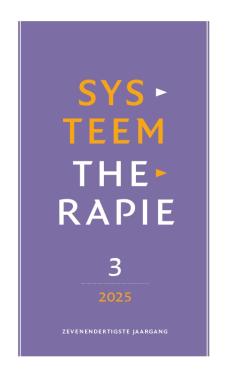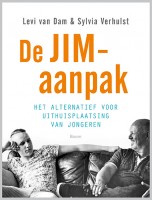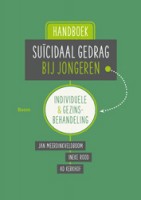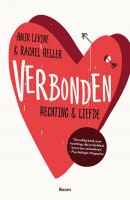Gezin en astma
Samenvatting
Chronische ziekten en gezinskenmerken zijn op een complexe manier met elkaar verbonden. Dit artikel is een verslag van een case-study naar de ontwikkeling en uitvoering van gezinsdiagnostiek bij gezinnen met kinderen met niet goed te reguleren astma. Het doel van deze diagnostiek is om in kaart te brengen welke gezinsfactoren bescherming kunnen bieden en welke factoren een bijdrage leveren aan het in stand houden of verergeren van de astmaklachten. Als uitgangspunt is het biologisch-gedragsmatig gezinsmodel van Beatrice Wood (2000) genomen, een model dat de complexe interactie tussen gezinsfactoren en ziekte wil verhelderen. Hoewel het aantal onderzochte gezinnen niet groot is, zijn de bevindingen interessant. In de gezinnen bleek sprake te zijn van ernstige, onuitgesproken conflicten tussen de ouders en een hechte, naar binnen gerichte gezinsstructuur. De ontwikkelde methode biedt aanknopingspunten om de bestaande behandeling van kinderen met astma aan te vullen met systeemtherapeutische interventies.
Summary The application of Beatrice Wood’s Biobehavioral Family Model to diagnostics and treatment of asthma: a case-study
Chronic illness and family characteristics interact in a complex way. This article reports on a case-study into the development and implementation of family assessment for families with children with severe asthma. The purpose of the assessment was to identify which family factors can protect from asthma symptoms and which factors contribute to maintaining or worsening them. The Biobehavioral Family Model of Beatrice Wood (2000) was taken as a starting point for this case-study. The model attempts to clarify the complex interaction between family factors and disease. Although the number of investigated families is not large, the findings are interesting. In all families there appeared to be serious hidden conflicts between the parents. We often found a close-knit, inwardly focused family structure and a tendency to keep conflicts and stressful experiences covered. The developed method offers clues to add systems therapeutic interventions to the existing treatment of some children with severe asthma.
Literatuur
- Baron, C., Veilleux, P., & Lamarre, A. (1992). The family of the asthmatic child. Canadian Journal of Psychiatry, 37(1), 12-16.
- Brock, A.J.L.L. de, Vermulst, A.A., Gerris, J.R.M., & Abidin R.R. (1992). NOSI: Nijmeegse Ouderlijke Stress Index. Amsterdam: Pearson.
- Campbell, T.L. (1986). The family’s impact on health: A critical review and annotated bibliography. Family Systems Medicine, 4(2/3), 135-328.
- Campbell, T.L. (2004). De effectiviteit van gezinsinterventies voor lichamelijke stoornissen. Gezinstherapie Wereldwijd, 15(4), 392-425.
- Davies, P.T., Harold, G.T., Goeke-Morey, M.C., & Cummings, E.M. (2002). Child emotional security and interparental conflict. Monographs of the Society for Research in Child Development, 67, 1-115.
- Di Blasio, P., Molinari, E., Peri, G., & Taverna, A. (1990). Family competence and childhood asthma. Family Systems Medicine, 8, 145-149.
- Eiser, C., Eiser, J.R., Town, C., & Tripp, J.H. (1991). Discipline strategies and parental perceptions of preschool children with asthma. British Journal of Medical Psychology, 64(1), 45-53.
- El-Sheick, M. (1994). Children’s emotional and physiological responses to interadult angry behavior: The role of interparental hostility. Journal of Abnormal Child Psychology, 22(6), 661-678.
- Garmezy, N., Masten, A., & Tellegen, A. (1984). A study of stress and competence in children: A building block for developmental psychology. Child Development, 55(1), 97-111.
- Gehring, T.M. (1995). GEST: Gezins Systeem Test. Amsterdam: Pearson.
- Gustafsson, P.A., Kjellman, N.I., Ludvigsson, J., & Cederblad, M. (1987). Asthma and family interaction. Archives of Disease in Childhood, 62(3), 258-263.
- Jansma, J.B.M., & Coole, R.L. de (1996). GKS-II: Gezinsklimaatschaal. Amsterdam: Pearson.
- Hermanns, J., Florin, I., Dietrich, M., Rieger, C., & Hahlweg, K. (1989). Maternal criticism, mother-child interaction and bronchial asthma. Journal of Psychosomatic Research, 33(4), 469-476.
- Lask, B., & Matthew, D. (1979). Childhood asthma: A controlled trial of family psychotherapy. Archives of Disease in Childhood, 54(2), 116-119.
- Meijer, A.M. (1993). De waarde van het ‘psychosomatisch gezinsmodel’ bij gezinnen waarin een kind aan astma lijdt. Directieve Therapie, 13(4), 357-375.
- Meijer, A.M. (1994). Gezinsinvloeden bij astma: over factoren die een beheersbaar van een niet beheersbaar astma onderscheiden. Amsterdam: Academisch proefschrift, Universiteit van Amsterdam.
- Minuchin, S., Baker, L., Rosman, B., Liebman, R., Milman, L., & Todd, T. (1975). A conceptual model of psychosomatic illness in children. Archives of General Psychiatry, 32(8), 1031-1038.
- Minuchin, S., Rosman, B.L., & Baker, L. (1978). Psychosomatic families: Anorexia nervosa in context. Cambridge, Mass.: Harvard University Press.
- Prange, M.E., Greenbaum, P.E., Silver, S.E., Friedman, R.M., Kutash, K., & Duchnowsky, A.J. (1992). Family functioning and psychopathology among adolescents with severe emotional disturbances. Journal of Abnormal Child Psychology, 20(1), 83-102.
- Purcell, K., Muser, J., Miklich, D., & Dietiker, K.E. (1969). A comparison of psychological findings in variously defined asthmatic subgroups. Journal of Psychosomatic Research, 13(1), 67-75.
- Reiss, D., & Olivieri, M.E. (1980). Family paradigm and family coping: A proposal for linking the family’s intrinsic capacities to its responses to stress. Family Relations, 29(4), 431-444.
- Veldhuizen, A. van, & Meijer, A.M. (1990). Overbescherming als opvoedingshouding bij ouders van levensbedreigend en niet-levensbedreigend zieke kinderen. Nederlands Tijdschrift voor de Psychologie en haar Grensgebieden, 45, 375-383.
- Weihs, K., Fisher, L., & Baird, M. (2002). Families, health, and behavior. Families, Systems, and Health, 20(1), 7-46.
- Wood, B. (1993). Beyond the `psychosomatic family’: A biobehavioral model of pediatric illness. Family Process, 32(3), 261-278.
- Wood, B. (2000). Evolving the Biobehavioral Family Model: the fit of attachment. Family Process, 39(3), 319-344.
- Wood, B., Watkins, J.B., Boyle, J.T., Noguiera, J., Zimand, E., & Caroll, L. (1989). The psychosomatic family model: An empirical and theoretical analysis. Family Process, 28(4), 261-278.
- Yorke, J., & Shuldham, C. (2005). Family therapy for asthma in children. Cochrane Database of Systematic Reviews, Issue 2, 1-16
 © 2009-2025 Uitgeverij Boom Amsterdam
© 2009-2025 Uitgeverij Boom Amsterdam
ISSN 0924-3631
De artikelen uit de (online)tijdschriften van Uitgeverij Boom zijn auteursrechtelijk beschermd. U kunt er natuurlijk uit citeren (voorzien van een bronvermelding) maar voor reproductie in welke vorm dan ook moet toestemming aan de uitgever worden gevraagd:
Behoudens de in of krachtens de Auteurswet van 1912 gestelde uitzonderingen mag niets uit deze uitgave worden verveelvoudigd, opgeslagen in een geautomatiseerd gegevensbestand, of openbaar gemaakt, in enige vorm of op enige wijze, hetzij elektronisch, mechanisch door fotokopieën, opnamen of enig andere manier, zonder voorafgaande schriftelijke toestemming van de uitgever.
Voor zover het maken van kopieën uit deze uitgave is toegestaan op grond van artikelen 16h t/m 16m Auteurswet 1912 jo. Besluit van 27 november 2002, Stb 575, dient men de daarvoor wettelijk verschuldigde vergoeding te voldoen aan de Stichting Reprorecht te Hoofddorp (postbus 3060, 2130 KB, www.reprorecht.nl) of contact op te nemen met de uitgever voor het treffen van een rechtstreekse regeling in de zin van art. 16l, vijfde lid, Auteurswet 1912.
Voor het overnemen van gedeelte(n) uit deze uitgave in bloemlezingen, readers en andere compilatiewerken (artikel 16, Auteurswet 1912) kan men zich wenden tot de Stichting PRO (Stichting Publicatie- en Reproductierechten, postbus 3060, 2130 KB Hoofddorp, www.cedar.nl/pro).
No part of this book may be reproduced in any way whatsoever without the written permission of the publisher.
Nieuwsbrief Boom Psychologie
Meld u nu aan en ontvang maandelijks de Boom Psychologie nieuwsbrief met aantrekkelijke aanbiedingen en de nieuwe uitgaven.
Aanmelden



